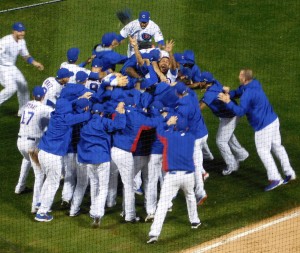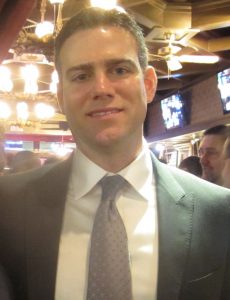Cubs hoping to end West Coast drought
By George Castle For Chronicle Media — October 7, 2016
Cubs players celebrate after beating the St. Louis Cardinals to win the 2015 National League Division series. They hope to repeat such a scene a few times this October. Chronicle photo)
Good thing manager Joe Maddon seemingly has his Cubs on their toes playing the battle-tested San Francisco Giants in the National League Division Series.
While boasting of almost across-the-board superiority over all previous Cubs playoff entrants since 1984, this year’s team is charged with breaking another historical, and negative team precedent: 0-for-the-West Coast in the postseason.
Factor in Pacific Time Zone-style scheduling, if you add in Phoenix, two hours behind Chicago during baseball season.
The West Coast often is a trail of tears in the regular season, with the time difference and big, pitching-oriented ballparks playing huge factors in coming up with mere handfuls of victories — if that many — on old-time tours of Los Angeles, San Francisco and San Diego. A bad West Coast swing also can be seen as a season-changer, like a July 1973 “family trip” that took the air out of an eight-game end-of-June first-place lead.
The dilemma the Cubs faced over the decades could be summed up by the experiences of Hall of Famer Billy Williams. Dutiful in adapting to the all-day schedule during his career, Williams typically would go to bed at 10 p.m. at his then-South Shore home. But when the Cubs flew to the West Coast and played on a Monday night after a Sunday-concluding homestand, he found his body clock still attuned to bedtime trying to hit the likes of Sandy Koufax or Juan Marichal at 8 p.m. local time. Physicians call the situation “shift-work disorder.”
Changes in schedules no doubt had an effect on the postseason.
The Cubs lost three in a row in San Diego in 1984 after going up 2-0 in the NL Championship Series at home. Steve Garvey and Bull Durham’s Gatorade-soaked first baseman’s mitt played starring roles along with Chicago Tribune columnist Mike Royko’s incitement of normally laid-back Jack Murphy Stadium fans.
In 1989, the youngish, heavily home-grown Cubs split two NLCS games with the veteran Giants at Wrigley Field as Mark Grace and Will Clark dueled as left-handed clutch hitters. But zipping out to windswept Candlestick Park, the Cubs dropped three straight close games by scores of 5-4, 6-4 and 3-2. Andre Dawson, playing gamely on just one good knee, hit just .105 (2-for-19), playing overaggressively trying to carry the Cubs. He rued the fact he should have just taken his walks, having been warned by Giants coach Dusty Baker the San Franciscans would not allow Dawson to beat them.
Fast forward to 2007 at the barn-like Chase Field in Phoenix. The Cubs lost the first two NL Division games against the Diamondbacks when manager Lou Piniella pulled effective Game 1 starter Carlos Zambrano after six innings, ostensibly to save him for a potential Game 4. Piniella let loose a dugout rant before Game 2 over the Zambrano second-guessing, even dropping a reference to the infamous billy goat. That did not put the Cubs at ease. Game 2 starter Ted Lilly threw his hat to the ground after serving up a Chris Young homer as the D’backs went on to sweep the Cubs three in a row.

Andre Dawson, playing gamely on just one good knee, hit just .105 (2-for-19), playing overaggressively trying to carry the Cubs in the 1989 playoffs against the San Francisco Giants. (Photo by George Castle)
A year later, the Cubs were practically beaten going out to Dodger Stadium for Game 3 of the NLDS. Two disastrous losses at Wrigley Field featuring nervous, jittery Cubs regulars and an unnaturally quiet home crowd set the tone. Sure enough, the Cubs lost 3-1 to bow out, prompting one unidentified player to wreck a dugout water pipe. Piniella again was on the defensive, and several of his pitchers privately questioned his game strategy in leaving starter Rich Harden in after falling behind.
So the count is seven postseason losses on the West Coast proper and two more in Phoenix. In the 103-win regular-season journey, the Cubs have busted through many historical precedents. They may get the chance to do it twice. If they beat the Giants with the first game by the Bay on Monday, they could get additional West Coast exposure if the Dodgers edge out Baker and the Nationals in the other NLDS series.
Maddon’s boys will attempt to accomplish the feat with these advantages over some of these previously mentioned Cubs entrants:
Dominant starting pitching
Can you imagine a Cubs team so blessed it could afford to start 18-game winner Jake Arrieta third in the playoff rotation? That’s the reality of 2016, when 19-4 Jon Lester, postseason-tested with the Red Sox, and ERA leader Kyle Hendricks got the call before Lester. A case also could have been made for John Lackey, whose October acumen dated back to his 2002 rookie season in Anaheim. Fifteen-game winner Jason Hammel isn’t even a factor in such discussions.
No other Cubs playoff teams could have gone five deep. In 1984, the fourth and fifth starters were the back-achin’ Scott Sanderson and Dick Ruthven. Manager Jim Frey opted for Sanderson in the “Garvey Game” instead of ace Rick Sutcliffe on three days’ rest, with predictable results. Five years later, the rotation dropoff was precipitous after Sutcliffe, Greg Maddux and Mike Bielecki. Piniella’s 2007 team had Jason Marquis and Sean Marshall as fourth- and fifth-starter options.

Theo Epstein has built a team in five years that led the Major Leagues in wins with 103 this season. (Photo by George Castle)
Lockdown closer
Nobody has ever seen 104 mph pitches, and Aroldis Chapman is the only man in baseball who throws them. Teams must frantically maneuver to avoid trailing the Cubs prior to the ninth and Chapman’s entrance. Making contact, period, is the challenge for hitters facing southpaw Chapman.
Baker’s reluctance to go to his shaky bullpen early could have been a factor in the Bartman Game in 2003. The manager later admitted he shortened his relief corps due to inconsistency. Lee Smith in 1984, Mitch Williams in 1989, Ryan Dempster in 2007 and Kerry Wood in 2008 had good success in the ninth, but none were comparable with Chapman.
Lineup balance
Too often the Cubs have fielded a predominantly right-handed lineup, susceptible to ace right-handers’ breaking pitches in the postseason. Lack of a productive left-handed bat in 2008 led to recriminations and the disastrous free-agent signing of Milton Bradley. Rarely has the team had two left-handed-hitting run producers in the batting order at the same time.
They stick out by their rarity in history – Billy Williams and George Altman in 1961-62, Grace and Henry Rodriguez in 1998. The fabled 1969 Cubs typically fielded just two lefty hitters – Williams and switch-hitter Don Kessinger. But when Kyle Schwarber joined Anthony Rizzo as a Cubs regular in the second half of 2015, the franchise took off.
Even with Schwarber out for the season with knee injuries, Maddon can complement Rizzo with lefty Jason Heyward, who remains a threat despite his off-season. Switch-hitters Ben Zobrist and Dexter Fowler are lineup staples. Lefty hitter Miguel Montero came on strong late.
Depth
The 2003 Miami Marlins were able to overwhelm the Cubs in Games 6 and 7 with a relentless – and deep – lineup. The Fighting Fish were able to sideline 94-RBI producer Juan Encarnacion in favor of 20-year-old Miguel Cabrera and franchise favorite Jeff Conine. The ’03 Cubs and other historical playoff teams had no such luxury. The regulars had to play with no ability to switch up.
With so many of his A-1 regulars able to play multiple positions, Maddon can insert starting-quality players Javy Baez, Willson Contreras and Jorge Soler into the lineup. Baez improves the defense at several positions, but he can be spotted based on the best matchups. Still learning his trade at catcher, Contreras is not forced to absorb a crash course behind the plate by playing every day.
Character
The volatile Carlos Zambrano was the ace of the 2007-08 staffs. ’Nuff said. Sammy Sosa already had been linked to PEDs, then was caught was a corked bat in 2003.
No such prima donnas exist on Maddon’s team. Given a long leash by the goateed skipper, the players appear to police themselves. Rizzo is a certified team leader. Every mother would want her daughter to marry Kris Bryant, who claims he has never tried alcohol. Lester and Arrieta are consummate professionals, while Kyle Hendricks perfected his pitching craft in much the same manner as ultimate baseball brain Greg Maddux.
— Cubs hoping to end West Coast drought —



